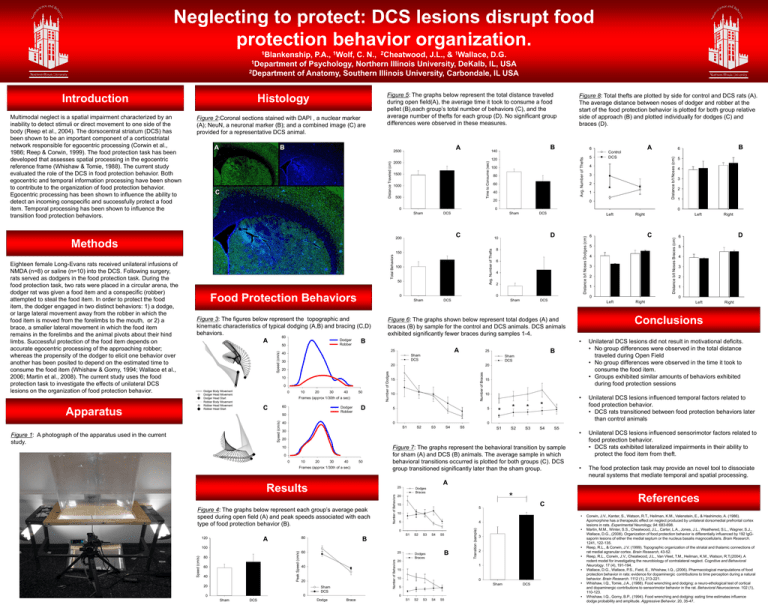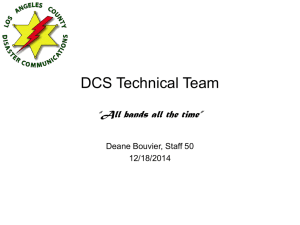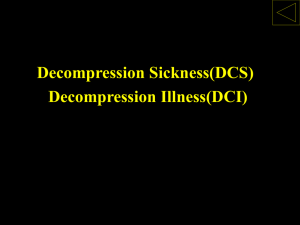Style D 36 by 54
advertisement

Neglecting to protect: DCS lesions disrupt food protection behavior organization. 1Blankenship, P.A., 1Wolf, C. N., 2Cheatwood, J.L., & 1Wallace, D.G. 1Department of Psychology, Northern Illinois University, DeKalb, IL, USA 2Department of Anatomy, Southern Illinois University, Carbondale, IL USA B C 120 2000 1500 1000 500 C C Avg. Number of Thefts Total Behaviors Dodger Robber 100 Sham Apparatus 10 20 30 60 40 Dodger Robber Speed (cm/s) 50 50 D 40 15 10 0 0 S2 S3 S4 10 20 30 40 50 Frames (approx 1/30th of a sec) Number of Behaviors 25 Dodges Braces 15 4 3 2 1 S4 S5 5 4 3 2 1 0 Right Left Right • Unilateral DCS lesions influenced sensorimotor factors related to food protection behavior. • DCS rats exhibited lateralized impairments in their ability to protect the food item from theft. • The food protection task may provide an novel tool to dissociate neural systems that mediate temporal and spatial processing. * 40 20 S2 S3 S4 S5 B Dodges Braces Brace C • 3 • 2 • 20 1 • 15 10 0 Sham 5 0 Dodge References 4 5 25 Number of Behaviors Peak Speed (cm/s) Speed (cm/s) 60 0 DCS 5 D 6 Unilateral DCS lesions influenced temporal factors related to food protection behavior. • DCS rats transitioned between food protection behaviors later than control animals • B Sham DCS Sham S3 10 100 0 S2 5 S1 80 20 C Right • * 20 0 40 S1 * Left A Figure 4: The graphs below represent each group’s average peak speed during open field (A) and peak speeds associated with each type of food protection behavior (B). 60 * * Figure 7: The graphs represent the behavioral transition by sample for sham (A) and DCS (B) animals. The average sample in which behavioral transitions occurred is plotted for both groups (C). DCS group transitioned significantly later than the sham group. Results A 1 Unilateral DCS lesions did not result in motivational deficits. • No group differences were observed in the total distance traveled during Open Field • No group differences were observed in the time it took to consume the food item. • Groups exhibited similar amounts of behaviors exhibited during food protection sessions 20 0 80 S5 2 • B 10 5 3 Conclusions 15 5 4 Right 6 Left Sham DCS 30 0 * 0 DCS 20 S1 10 120 2 25 20 Frames (approx 1/30th of a sec) Figure 1: A photograph of the apparatus used in the current study. A 30 0 C 4 Sham Number of Braces Dodger Body Movement Dodger Head Movement Dodger Head Start Robber Body Movement Robber Head Movement Robber Head Start D 6 Sham DCS 0 1 Left 8 DCS 25 10 2 DCS B 20 3 5 0 Figure 6: The graphs shown below represent total dodges (A) and braces (B) by sample for the control and DCS animals. DCS animals exhibited significantly fewer braces during samples 1-4. 40 4 B 6 0 0 Transition (sample) Speed (cm/s) 50 40 10 0 Number of Dodges A 60 Sham 50 60 80 DCS 200 Figure 3: The figures below represent the topographic and kinematic characteristics of typical dodging (A,B) and bracing (C,D) behaviors. 5 A Control DCS 0 Sham Food Protection Behaviors 6 20 150 Eighteen female Long-Evans rats received unilateral infusions of NMDA (n=8) or saline (n=10) into the DCS. Following surgery, rats served as dodgers in the food protection task. During the food protection task, two rats were placed in a circular arena, the dodger rat was given a food item and a conspecific (robber) attempted to steal the food item. In order to protect the food item, the dodger engaged in two distinct behaviors: 1) a dodge, or large lateral movement away from the robber in which the food item is moved from the forelimbs to the mouth, or 2) a brace, a smaller lateral movement in which the food item remains in the forelimbs and the animal pivots about their hind limbs. Successful protection of the food item depends on accurate egocentric processing of the approaching robber; whereas the propensity of the dodger to elicit one behavior over another has been posited to depend on the estimated time to consume the food item (Whishaw & Gorny, 1994; Wallace et al., 2006; Martin et al., 2008). The current study uses the food protection task to investigate the effects of unilateral DCS lesions on the organization of food protection behavior. 100 0 Methods B 140 Distance b/t Noses (cm) A 2500 Distance b/t Noses Braces (cm) B A Avg. Number of Thefts A Figure 8: Total thefts are plotted by side for control and DCS rats (A). The average distance between noses of dodger and robber at the start of the food protection behavior is plotted for both group relative side of approach (B) and plotted individually for dodges (C) and braces (D). Distance b/t Noses Dodges (cm) Figure 2:Coronal sections stained with DAPI , a nuclear marker (A); NeuN, a neuronal marker (B); and a combined image (C) are provided for a representative DCS animal. Distance Traveled (cm) Multimodal neglect is a spatial impairment characterized by an inability to detect stimuli or direct movement to one side of the body (Reep et al., 2004). The dorsocentral striatum (DCS) has been shown to be an important component of a corticostriatal network responsible for egocentric processing (Corwin et al., 1986; Reep & Corwin, 1999). The food protection task has been developed that assesses spatial processing in the egocentric reference frame (Whishaw & Tomie, 1988). The current study evaluated the role of the DCS in food protection behavior. Both egocentric and temporal information processing have been shown to contribute to the organization of food protection behavior. Egocentric processing has been shown to influence the ability to detect an incoming conspecific and successfully protect a food item. Temporal processing has been shown to influence the transition food protection behaviors. Histology Time to Consume (sec) Introduction Figure 5: The graphs below represent the total distance traveled during open field(A), the average time it took to consume a food pellet (B),each group’s total number of behaviors (C), and the average number of thefts for each group (D). No significant group differences were observed in these measures. S1 S2 S3 S4 S5 DCS • • Corwin, J.V., Kanter, S., Watson, R.T., Heilman, K.M., Valenstein, E., & Hashimoto, A. (1986). Apomorphine has a therapeutic effect on neglect produced by unilateral dorsomedial prefrontal cortex lesions in rats. Experimental Neurology, 94: 683-698. Martin, M.M., Winter, S.S., Cheatwood, J.L., Carter, L.A., Jones, J.L., Weathered, S.L., Wagner, S.J., Wallace, D.G., (2008). Organization of food protection behavior is differentially influenced by 192 IgGsaporin lesions of either the medial septum or the nucleus basalis magnocellularis. Brain Research. 1241, 122-135. Reep, R.L., & Corwin, J.V. (1999). Topographic organization of the striatal and thalamic connections of rat medial agranular cortex. Brain Research, 43-52. Reep, R.L., Corwin, J.V., Cheatwood, J.L., Van Vleet, T.M., Heilman, K.M., Watson, R.T,(2004). A rodent model for investigating the neurobiology of contralateral neglect. Cognitive and Behavioral Neurology. 17 (4), 191-194. Wallace, D.G., Wallace, P.S., Field, E., Whishaw, I.Q., (2006). Pharmacological manipulations of food protection behavior in rats: evidence for dopaminergic contributions to time perception during a natural behavior. Brain Research. 1112 (1), 213-221. Whishaw, I.Q., Tomie, J.A., (1988). Food wrenching and dodging: a neuro-ethological test of cortical and dopaminergic contributions to sensorimotor behavior in the rat. Behavioral Neuroscience. 102 (1), 110-123. Whishaw, I.Q., Gorny, B.P., (1994). Food wrenching and dodging: eating time estimates influence dodge probability and amplitude. Aggressive Behavior. 20, 35-47.







